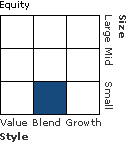| BNY Mellon IP MidCap Stock Init |
|
 |
|
| Release date as of 2025-09-30. Data on page is subject to change. |
|
|
Overall Morningstar
Rating™
|
| What is this?
|
|
 |
| As of 2025-09-30 |
|
Out of 373
Mid-Cap Blend Funds
|
|
|
|
|
|
| Total Fund Assets ($ Mil) |
| 156.7 |
|
|
|
| Investment Objective & Strategy |
|
| The investment seeks investment results that are greater than the total return performance of publicly traded common stocks of medium-size domestic companies in the aggregate, as represented by the Standard & Poor's MidCap 400® Index (S&P 400 Index).
|
|
| To pursue its goal, the fund normally invests at least 80% of its net assets, plus any borrowings for investment purposes, in stocks of mid-cap companies. It invests in growth and value stocks, which are chosen through a disciplined investment process that combines computer modeling techniques, fundamental analysis and risk management. |
|
|
| Morningstar Category: Mid-Cap Blend |
|
| The typical mid-cap blend portfolio invests in U.S. stocks of various sizes and styles, giving it a middle-of the-road profile. Most shy away from high-priced growth stocks but aren't so price-conscious that they land in value territory. Stocks in the middle 20% of the capitalization of the U.S. equity market are defined as mid-cap. The blend style is assigned to portfolios where neither growth nor value characteristics predominate.
|
|
|
| Mid Cap Funds: The securities of companies with market capitalizations below $10 billion may be more volatile and less liquid than the securities of larger companies. |
|
|
| % of Net Assets |
 |
U.S. Stocks |
97.7 |
 |
Non-U.S. Stocks |
2.0 |
 |
Bonds |
0.0 |
 |
Cash |
0.4 |
 |
Other |
0.0 |
|
|
 |
| Data through 2025-09-30 |
|
|
|
|
| Morningstar Equity Sectors |
|
|
|
% of Stocks |
 |
Cyclical |
38.67 |
 |
Basic Materials |
5.10 |
 |
Consumer Cyclical |
12.24 |
 |
Financial Services |
13.46 |
 |
Real Estate |
7.87 |
|
|
|
 |
Sensitive |
43.12 |
 |
Communication Services |
1.98 |
 |
Energy |
4.21 |
 |
Industrials |
20.76 |
 |
Technology |
16.17 |
|
|
|
 |
Defensive |
18.19 |
 |
Consumer Defensive |
5.28 |
 |
Healthcare |
10.49 |
 |
Utilities |
2.42 |
|
| Data through 2025-09-30 |
|
|
| Total Number of Stock Holdings |
250 |
| Total Number of Bond Holdings |
0 |
| % of Net Assets in Top 10 Holdings |
12.81 |
|
|
| Turnover % |
(as of 2024-12-31) |
59.03 |
| 30 Day SEC Yield % |
0.00 |
|
|
Sector |
P/E |
% of Net
Assets
|
 |
 |
 |
 |
 |
 |
EMCOR Group Inc |
 |
31.09 |
2.42 |
 |
WESCO International Inc |
 |
17.68 |
1.42 |
 |
First Horizon Corp |
 |
13.38 |
1.35 |
 |
ITT Inc |
 |
27.73 |
1.35 |
 |
US Foods Holding Corp |
 |
31.75 |
1.23 |
 |
 |
Watts Water Technologies Inc Class A |
 |
29.95 |
1.15 |
 |
Lincoln Electric Holdings Inc |
 |
27.17 |
1.00 |
 |
Flex Ltd |
 |
--- |
0.99 |
 |
Pure Storage Inc Class A |
 |
228.76 |
0.97 |
 |
Grand Canyon Education Inc |
 |
26.50 |
0.93 |
 |
|
 |
|
|
|
|
|
| Loss of Money, Not FDIC Insured, Growth Investing, Value Investing, Market/Market Volatility, Equity Securities, Management, Mid-Cap |
|
| Show Risk Definitions |
|
|
| Inception Date: 1998-05-01 |
|
| Peter D. Goslin (2017-03-09) |
|
| Peter is a member of Newton’s equity income team. Peter oversees multi-factor equity portfolio management and is responsible for the portfolio management and implementation of systematic equity investment strategies. Peter collaborates with quantitative and fundamental equity researchers to evolve the systematic investment processes and set the research agenda.
Peter joined Newton in September 2021, following the integration of Mellon Investments Corporation’s equity and multi-asset capabilities into the Newton Investment Management Group. Before joining Newton, Peter was a senior portfolio manager and trader at Mellon Investments Corporation, Mellon Capital and Mellon Equity Associates (all BNY Mellon group companies).
Prior to joining BNY Mellon, Peter worked as a proprietary derivatives trader and NASDAQ market maker for Merrill Lynch in New York. Previously, he ran Merrill’s equity index option desk at the Chicago Mercantile Exchange.
Peter has a BS in Finance and Computer Science from St. Vincent College and an MBA in Finance from the University of Notre Dame. He received his CFA designation in 2000 and is a member of the CFA Institute and the CFA Society Pittsburgh. |
|
|
|
| BNY Mellon Investment Adviser, Inc |
|
|
|
|
|
| Newton Investment Management North America, LLC |
|
|

© Copyright 2025 Morningstar, Inc. All rights reserved. Morningstar, the Morningstar logo, Morningstar.com, Morningstar Tools are either trademark or service marks of Morningstar, Inc. The information contained herein: (1) is proprietary to Morningstar and/or its content providers; (2) may not be copied or distributed; and (3) is not warranted to be accurate, complete or timely. Neither Morningstar nor its content providers are responsible for any damages or any losses arising from any use of information. Past performance is no guarantee of future performance. |
|
Past performance is no guarantee of future results.
Returns will vary and shares may be worth more or less than their original cost when sold.
|
|





















